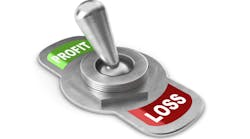Organizations are always looking for ways to increase profit margins. Too often we default to lowering costs as the way to do this. As I mentioned in a previous article, no organization has had sustainable success by simply cutting costs and relying on new methodologies. The most sustainable success comes from focusing on growth, innovation and effectiveness, and changing the overall mindset of the organization.
There are only three ways that margins (and therefore profits) can be increased: Increasing revenues and maintaining costs; maintaining revenues and decreasing costs; and increasing revenues and decreasing costs. You need to be able to master all three.
In order to master those three situations, you need to pull the right lever at the right time, and there are only so many levers your organization can pull. Pulling those levers can have the maximum impact for the minimum amount of effort. Consider a car jack, where a few short turns can lift a 2,000-pound car off the ground in a few minutes. That is an effective way to increase margins.
If you really want to master margins, you need to create the business equivalent of a hydraulic jack, where all you need to do is push a button and raise that same car in only a few seconds. This will really help you break open your margins. You create your own hydraulic margin jack.
In order to do that, you need to first know what levers to pull and when to pull them. Here are the key levers your organization can use to dramatically increase margins:
- Pricing and payment terms. Knowing when to increase and decrease prices, using different pricing strategies and payment terms to accelerate revenue collection, and the different pricing mixes you can use.
- Procurement and managing suppliers. Leveraging the assets you are already buying (or have already bought), reducing costs on commodities, and maximizing value from supplier relationships.
- Cost of goods sold. Minimizing the cost of making your product, ensuring you maintain the expected level of quality, and minimizing defects and obsolescence.
- Supply chain optimization. Reducing the number of touch points within the supply chain, ensuring that supply meets demand, and optimizing inventory and distribution strategies.
- Customer growth and retention. Selling additional products and services to existing customers, retaining those customers, and leveraging them to bring in new customers.
- Employee empowerment and retention. Attracting and keeping the right people, reducing absenteeism and unproductive turnover, and fostering an environment that provides excellence on the front lines.
- Brand recognition. Increasing reputation, drawing customers to you, and reducing the cost of new customer acquisition.
- Operational excellence. Challenging the status quo, effectively on-boarding new customers, using technology to accelerate excellence, and aligning tactics with overall strategy.
- Innovating and collaborating. Developing new ideas, maximizing the impact of those ideas, and integrating them into the fabric of your organization.
Look for my next article where I will give you specific metrics you can use to maximize your ability to use these levers to improve performance and increase profitability.
Are you maximizing the impact from the levers you are already pulling, and are there other levers you need to start pulling?





